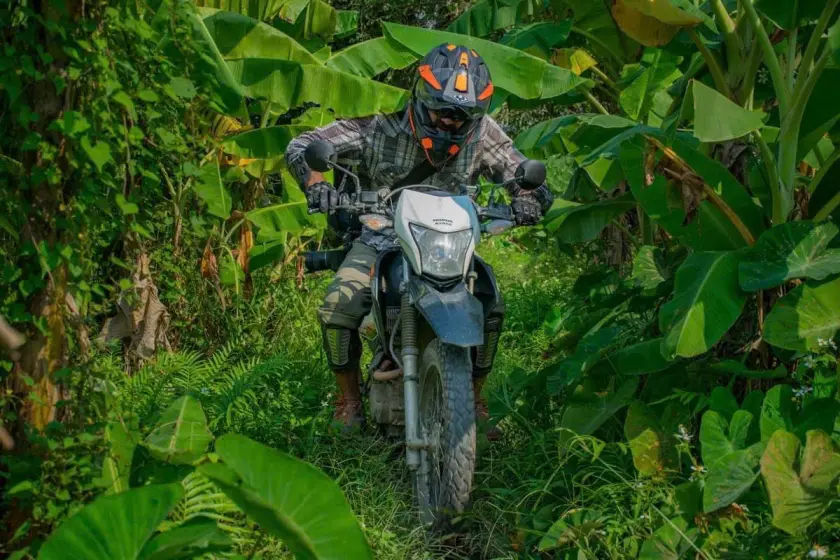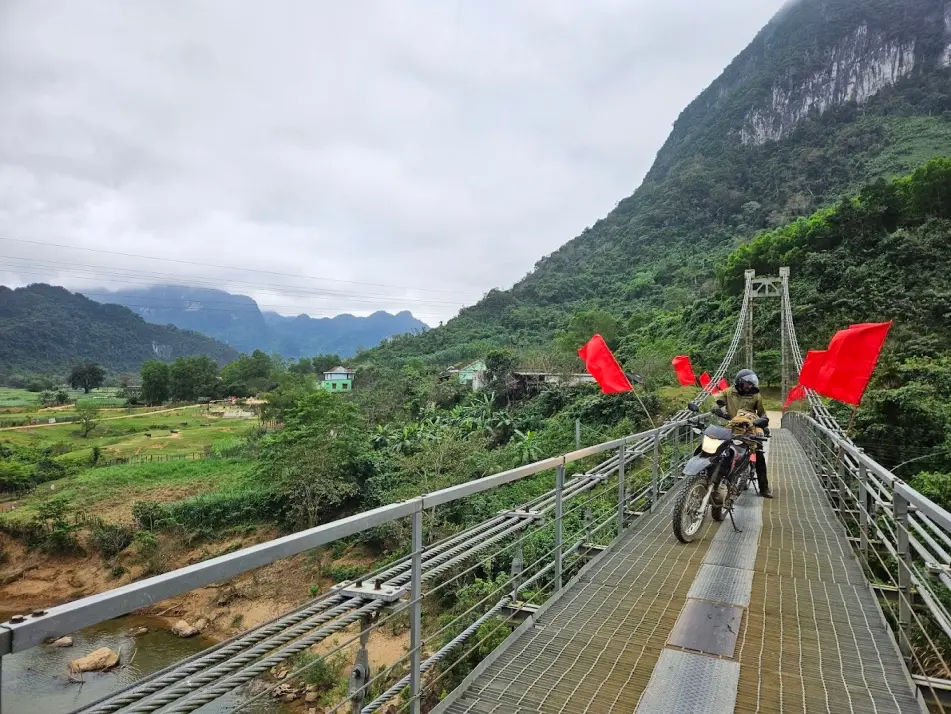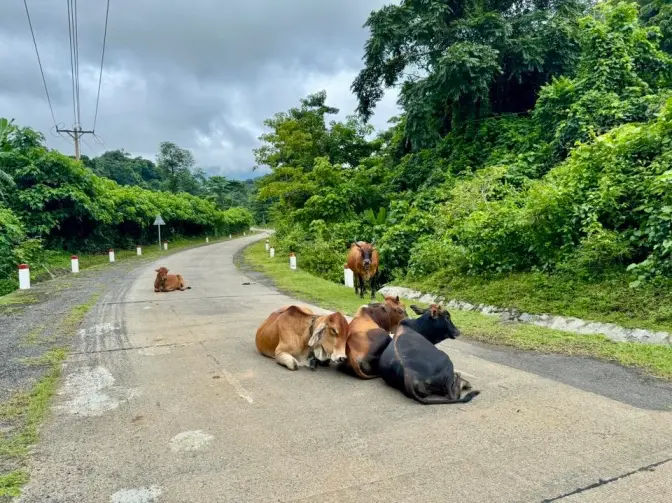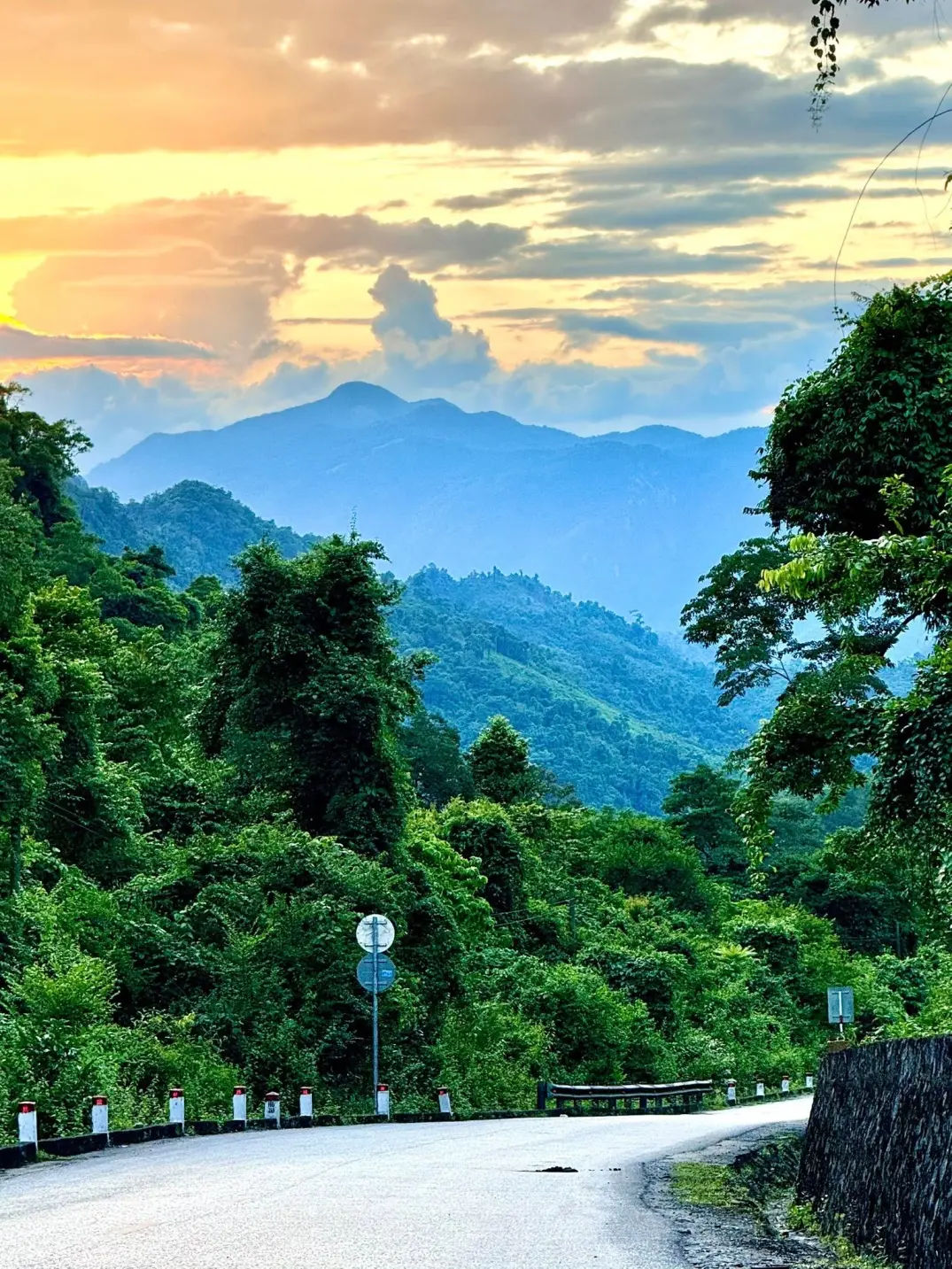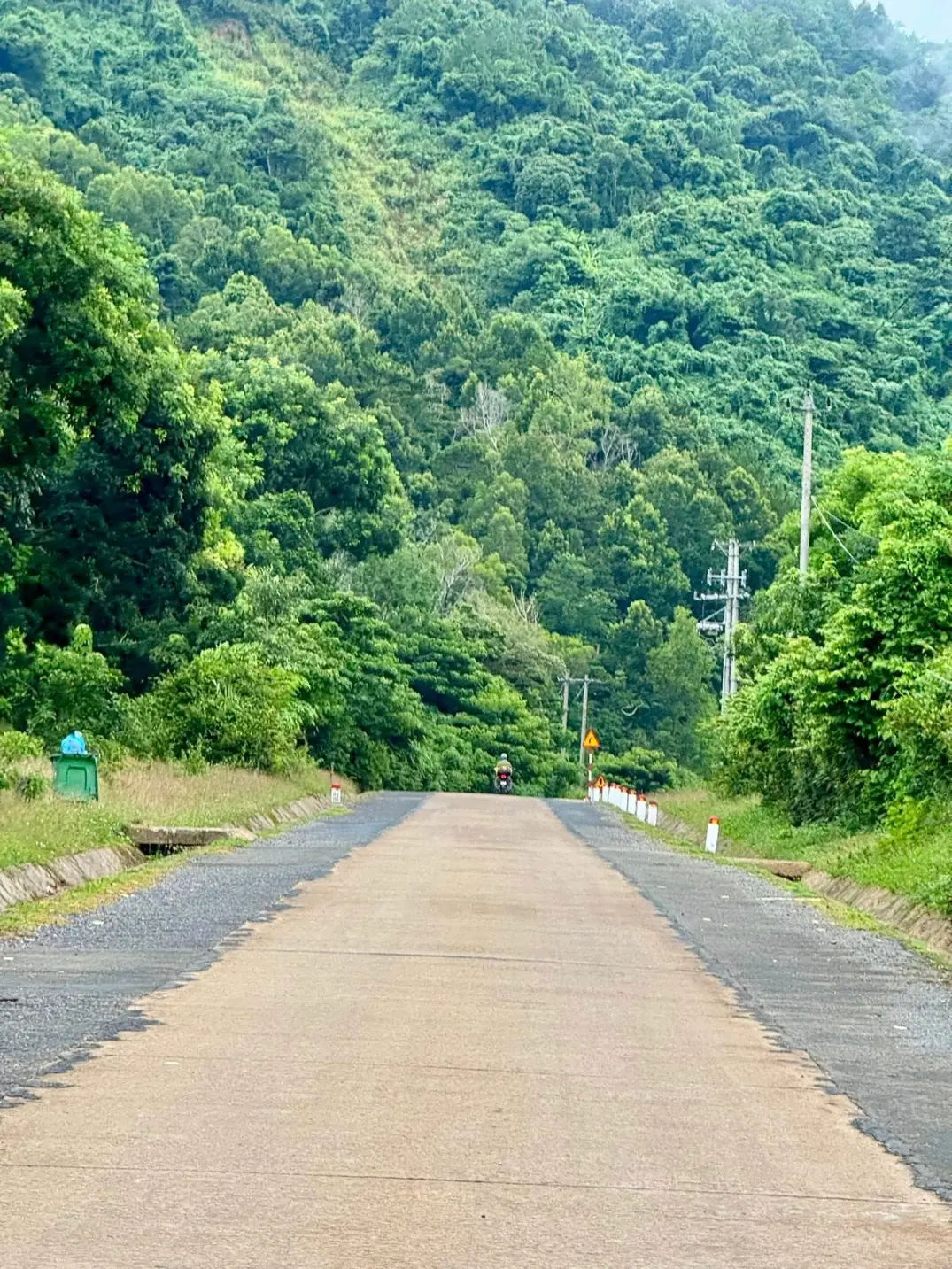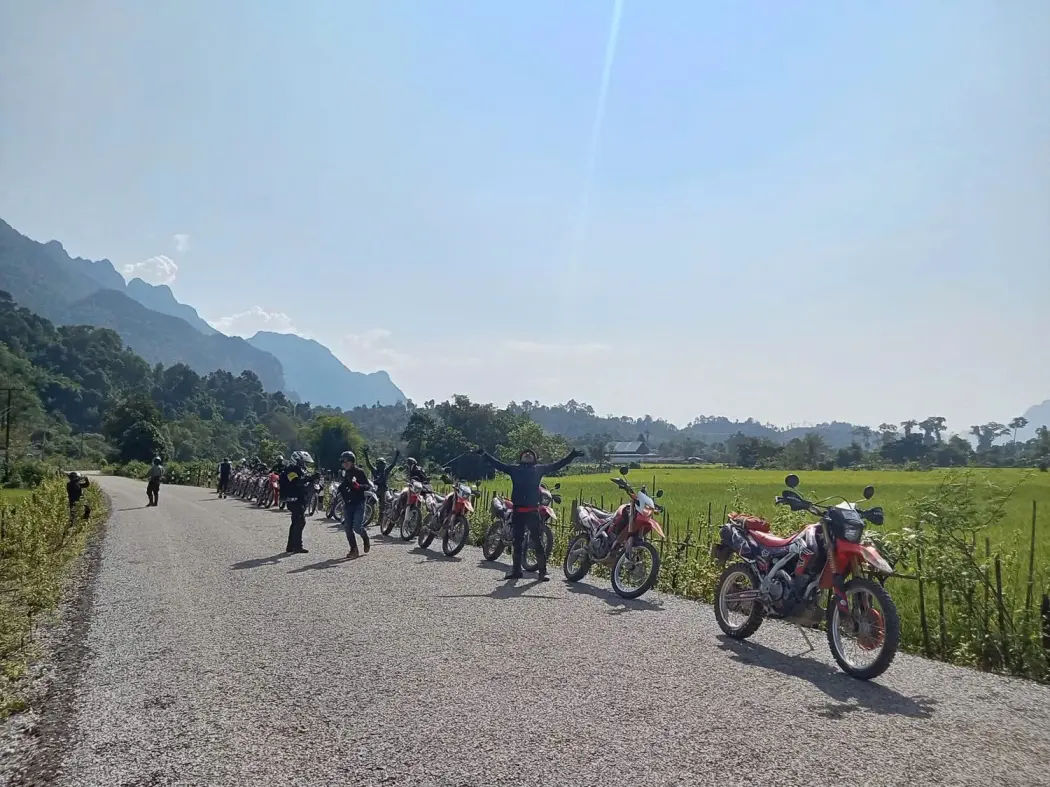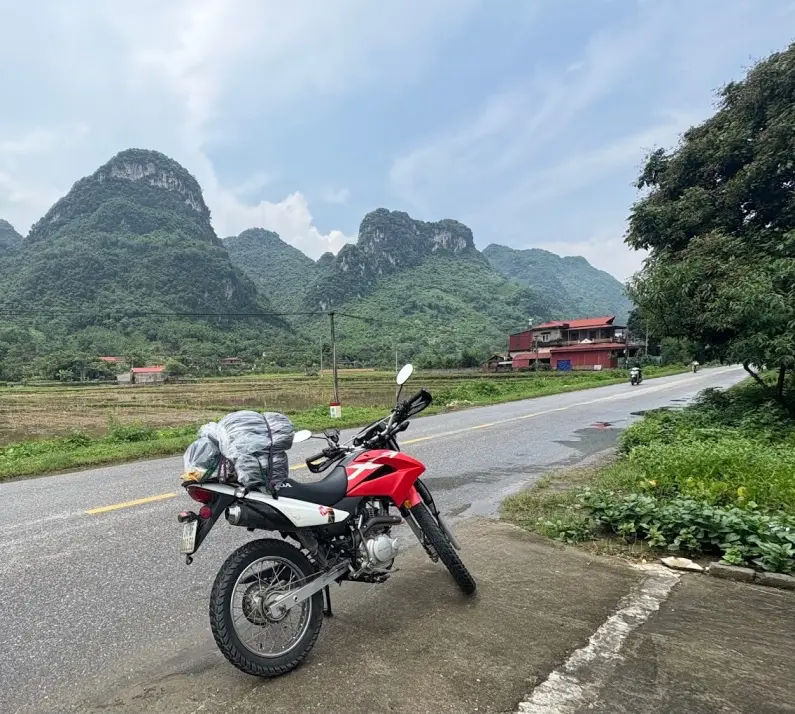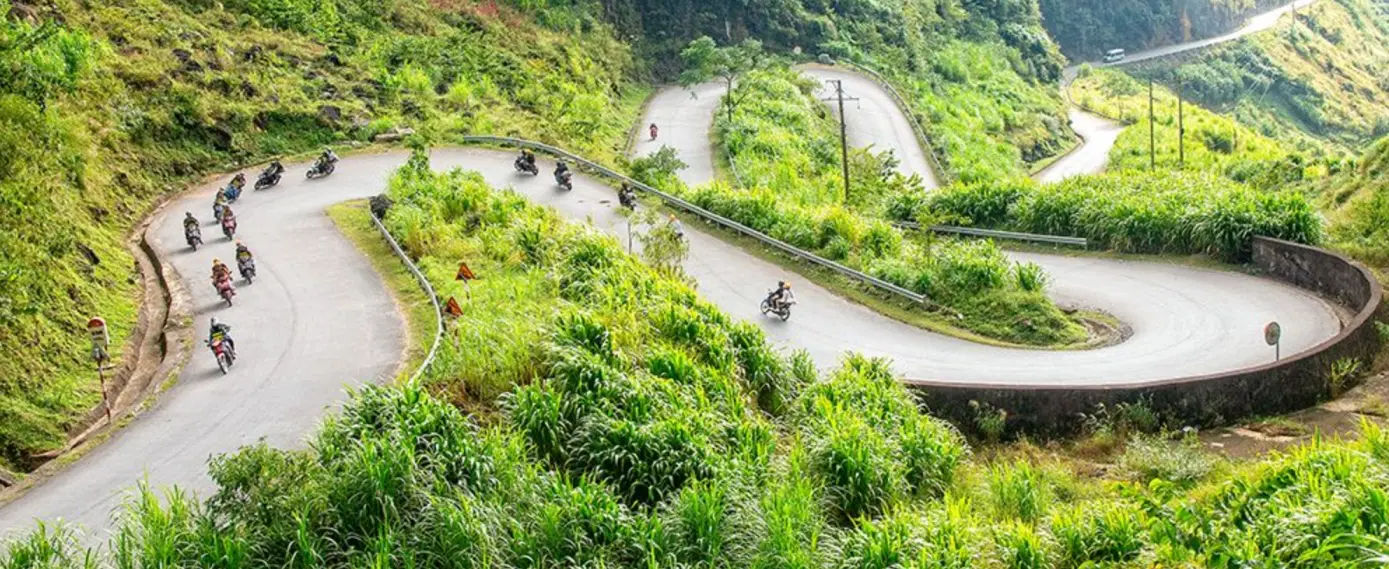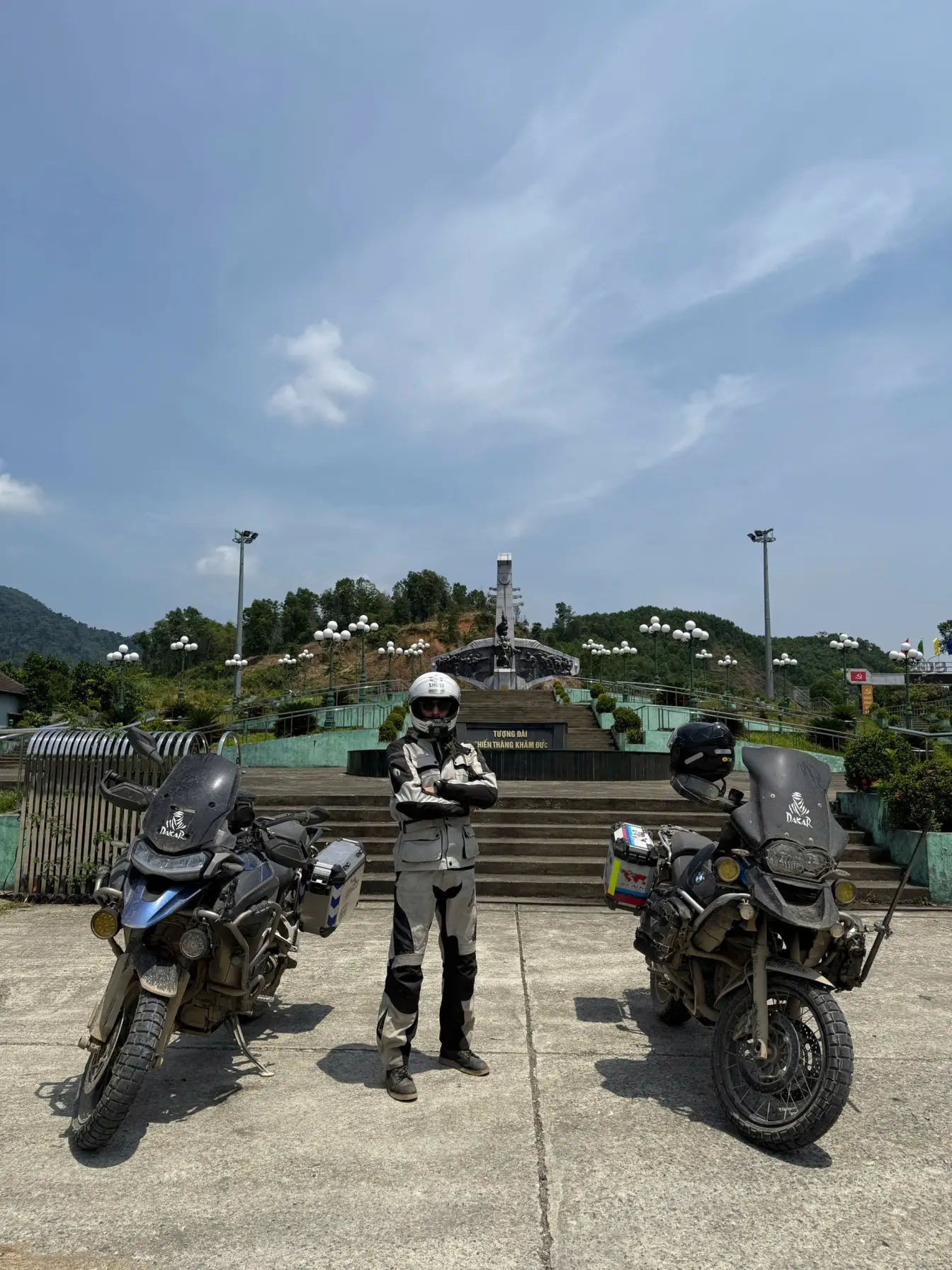
Few routes in the world capture the spirit of adventure quite like the Ho Chi Minh Road, a breathtaking ride that runs along Vietnam’s mountainous western spine. Stretching nearly 1,880 kilometers from Ho Chi Minh City in the south to Hanoi in the north (or vice versa), this road weaves through misty mountains, remote valleys, and untouched jungles that border both Laos and Cambodia.
Often confused with the wartime Ho Chi Minh Trail, which actually ran mostly through Laos, today’s Ho Chi Minh Road is a fully paved highway that connects the entire length of Vietnam. It offers riders an unbroken, scenic route filled with curves that seem to flow naturally through the landscape. For motorbike riders, this is more than just a road trip; it’s a symbol of Vietnam’s enduring beauty and resilience.
To give you an overview of how’s the Ho Chi Minh Road, just imagine ride through a ribbon of single lined road winding effortlessly through emerald forests, past rivers that gleam like veins of cobalt, and limestone peaks rising like ancient fortresses.
Having explored this route for years on our Vietnam motorbike tours, I can say with confidence that riding the Ho Chi Minh trail remains one of the most do motorbike experiences in Southeast Asia. It’s a route that continues to thrill riders, photographers, and adventurers who seek the true essence of Vietnam, let’s go…
Riding Along the Historical Ho Chi Minh Trail in Vietnam: Introduction
The journey along the Ho Chi Minh Trail (also referred to in parts as the Ho Chi Minh Road) is a journey of discovery through the series of super quiet, long roads crossing jungles and wet terrain, along the sparsely populated mountainous villages. In this guide, you’ll discover why’s recommended to motorbike adventurers choose this route, what to expect in terms of landscapes and the best part of the trail, and how to prepare to make the most of it.
Overview of the Ho Chi Minh Trail and its historical significance
The original Ho Chi Minh Trail was a vast network of hidden paths and supply routes built during the Vietnam War to transport war machineries, troops equipments and materials from North Vietnam through Laos and Cambodia into the South. Over time, sections of this historic trail were transformed into what is now the Ho Chi Minh Road, also known as the Trường Sơn route, stretching through the mountainous heart of Vietnam right after riding out of Phong Nha Ke Bang national park. Riding along it today offers not only breathtaking scenery but also a tangible sense of history, where every single section of this road and valley tells a story from the nation’s past.
| Route | A historic highway running along Vietnam’s mountainous western spine, connecting Saigon (Ho Chi Minh City) with Hanoi. |
|---|---|
| Total Distance | Approximately 1,880 kilometers (full route). |
| Recommended Duration | About two weeks to ride the entire route comfortably. |
| Scenery Highlights | Verdant highlands, jungle valleys, limestone mountains, rivers, borderlands, and rural villages — showcasing Vietnam’s natural diversity. |
| Main Attractions | Caves, waterfalls, historical war sites, scenic mountain passes, peaceful local communities, and incredible motorbike roads. |
| Road Conditions | Mostly well-paved and wide with light traffic; occasional narrow or busy sections, especially near major towns. |
| Best Time to Ride | March to September — ideal for clear weather, minimal rain, and vivid landscapes. |
Why motorbike adventurers choose this route
There are plenty of reasons why motorbike adventurers are drawn to ride along the Ho Chi Minh Road, beside the remoteness and adventure ride, there re amazing sceneries and different sort of terrains, there are war memorial and battle zones, airfields that echoes the past. And, if I share with you a quick overview of the road, before planning your ride, here’s a concise experience writing of what to expect along the historic trail, as one of Vietnam’s most legendary motorbike routes. This summary highlights essential details such as the route’s distance, duration, scenery, and travel conditions to help you prepare for the journey from Saigon to Hanoi.
You can ride it in either direction, Hanoi to Saigon, or start in Saigon and end in Hanoi, the experience is equally rewarding both ways. While the official road technically starts and ends just outside the city centers, most riders begin from downtown Saigon or Hanoi for convenience.
The route extends beyond both cities, though some of those outer sections remain incomplete. Many travelers join the road at different points using east–west connectors that link Vietnam’s coast to the highlands. If you can only ride part of it, aim for the Central part, especially the legendary Western Ho Chi Minh Road between Khe Sanh and Phong Nha, often called one of the most beautiful motorbike rides in Vietnam.
Quick summary of scenic landscapes and cultural highlights
Imagine yourself on an adventure on this part of Vietnam: the stretch between Khe Sanh and Phong Nha stands out and I advice to ride it through the western part of the trail. One rider described on a recent tour, “long stretches where I’d go hours without seeing another tourist on a motorbike.” and that’s true.
As you ride through places like A Lưới or Long Sơn, you’ll pass ethnic minority villages, roadside cafés in rustic towns, and remnants of wartime airfields or forts near the borderlands, all stitched into the route’s narrative.
About the Ho Chi Minh Trail
The Ho Chi Minh Trail stretches about 1,880 km between Hanoi and Ho Chi Minh City (Saigon), literally from the north to the south of Vietnam, taking around two weeks to complete at a comfortable ride of around 5-6 hours a day. Most riders cover 100-200 km a day, though on our programs, because we use more comfortable rides, we cover around 300-400km daily on our big motorbike tours . You can ride the route in either direction, divided into flexible sections, with the Western Ho Chi Minh Road between Khe Sanh and Phong Nha needing extra planning due to limited stops. Weather is best from March to September; expect mist and cooler air from October to February in the northern stretches.
Geography and major sections of the trail
The Road (and parts of the historical Trail) spans a long arc through Vietnam’s western spine. According to Duc, our rider guide, the full route covers approximately 2000 km from near Ho Chi Minh City (Saigon) to near Hanoi, though many riders choose specific segments rather than the full stretch. For motorbike adventures, often the Central portion offers the richest experience.
Major sections can be roughly split into:
- Southern section: from the south up into the Central Highlands.
- Central section: mountainous terrain, remote valleys, passes, and iconic sections between the highlands and the coast.
- Northern section: the final part towards Hanoi, with highland villages and remote roads.
Historical background and its role in Vietnam’s history
The original Trail (1959–1975) was a remarkable wartime supply network that ran from areas near Vinh city (~250 south of Hanoi) and Dong Hoi in central coasts, cutting through the Trường Sơn Mountains and crossing into Laos and Cambodia before reaching the Central Highlands near Kon Tum and Gia Lai.
It was engineered under the leadership of General Võ Bẩm and later supported by legendary figures such as General Võ Nguyên Giáp (My #1 hero) and President Hồ Chí Minh himself. After reunification, the government began constructing the modern Road (the one we ride across these days), also known as the Trường Sơn Highway or Ho Chi Minh Trail West, between 1975 and 1979, linking remote mountain regions and former war zones like Khe Sanh and Phong Nha with smooth, paved routes.
Once hidden from the world, this historic corridor only opened to public traffic in the early 2000s, transforming into one of Vietnam’s most scenic and symbolic motorbike routes today.
Climate and best seasons for motorbike trips
Riding the epic road means experiencing a range of weather conditions depending on altitude, region, and season. Here are some quick tips to plan your trip: Check out The best time to visit Vietnam in general
- March to May: The best months for most riders, clear skies, dry roads, and mild temperatures.
- September to November: Another great window, especially in the central and northern sections.
- June to August: Expect heavy rain, humidity, and occasional storms in central Vietnam, plan accordingly.
- Highland areas: Early morning mist and cool starts are common; pack warm layers and waterproof gear.
Must-Ride Sections of the Trail
This part is my own recommendations and true me, you’ll have fun riding this section. Leaving Ho Chi Minh City, the first stretch north toward the trail can feel gritty, a blur of trucks, factory towns, and morning haze through Bình Dương and Bến Cát. Leave before dawn and the ride is smoother, with wide roads leading past rubber plantations and the red earth that hints at the Central Highlands ahead.
Beyond Đồng Xoài (“Mango Field”), the scenery opens up: cashew trees, jackfruit groves, and the faint outline of distant volcanoes. By the time you reach Gia Nghĩa, you’re surrounded by cool air, coffee farms, and the hum of highland life. Stop here for a night and visit Liên Nung Waterfall before continuing toward Buôn Ma Thuột, Vietnam’s coffee capital. The ride from here rolls through fertile plateaus, pine forests, and borderland views, blending rural charm with a quiet sense of freedom that defines this legendary route.
Northern Highlands Route
I start with key viewpoints and photo opportunities, the northern highlands of the trail offer some of Vietnam’s most dramatic scenery, sweeping bends, rugged ridges, and misty passes dotted with remote villages. Many riders describe this stretch as unforgettable, with one sharing, “The view from the trail, looking down over endless green is an image I’ll never forget.” Along the way, limestone cliffs rise sharply from the jungle, and there are plenty of roadside spots to pull over for photos of the road snaking into the hills.
Road Conditions and Difficulty Level
Most of the ride along the Ho Chi Minh Road is sealed and well-maintained though sections can narrow or shift to concrete slabs. Traffic is no where to see, but the challenge lies in distance and isolation, services can be scarce for hours at a time. Between Khe Sanh and Phong Nha, for instance, riders often note there’s only one guesthouse and a single fuel stop right out of the Khe Sanh. I recommend this as a serious advice, If it’s your first time and riding solo in Vietnam, go with a friend, it makes all the difference.” This isn’t a beginner’s route, but for seasoned riders, it’s pure adventure on two wheels.
Central Vietnam Section
I personally love he mountain passes and hidden villages, this stretch of the trail winds through dramatic passes like the Sa Mù Pass, remote hamlets, and thick jungle corridors. The route from Phong Nha is often hailed by riders as one of Vietnam’s most thrilling segments, “the road snakes through forested hills and it easily one of the most exciting parts of this already epic journey.” Hidden villages dot the path, where you might pause for a roadside coffee or a quiet rest. As Mark, one of our traveler recalled, “When we rode our bikes down to the river, word spread fast that westerners had arrived few make it this far.”
Cultural Experiences and Local Interactions
Beyond the scenery, the Ho Chi Minh Road is rich in human encounters from kids waving as you pass to locals inviting you for tea in wooden stilt houses. Small cafés by waterfalls and war memorials along the route add to its cultural depth. Riders recommend wearing long sleeves for sun protection and carrying basic gear, as conditions can change quickly. Taking the time to stop, chat, and explore gives the journey its true meaning.
Southern Vietnam Pathways
Heading south along the Ho Chi Minh Trail, the landscape slowly transforms from misty mountains to warmer, tropical lowlands. Between Phong Nha and Khe Sanh (about 220 km), riders descend from limestone karsts into deep valleys and jungle corridors. Continuing south, the route threads through A Lưới and over the scenic Sa Mù Pass before dropping toward Prao and Thanh My, a winding 190 km stretch of remote forest roads and quiet riverside towns. Further on, the scenery opens into the lush farmlands near Kon Tum and Pleiku, where coffee plantations and red basalt soil signal the Central Highlands. Each leg of this journey blends mountain passes, river crossings, and local life, a gradual shift in rhythm and climate that defines the southern reaches of the trail.
Safety tips for challenging terrains
Some things to watch out for along the trail:
- Limited fuel and repair stops: If you ride along the western section of the trail, watch out as services are sparse, there will be long stretches without a single fuel station. Always top up when you can and carry extra fuel if possible.
- Rapid weather changes: Rain or mist can make mountain passes slippery and reduce visibility. Pack reliable wet-weather gear and ride cautiously, especially after heavy rain.
- Varying road surfaces: While most of the route is paved, certain sections use distinctive concrete slabs typical of the Western Ho Chi Minh Road. These can feel uneven and wear down tyres faster — check your suspension and tyre pressure regularly.
Essential Tips for Riding the Trail
Think of this as a chat between fellow riders, or an advice from me, well, if you’re heading out on the Ho Chi Minh Trail ride, pack smart and ride prepared. Bring a basic tool kit if you can, and a little extra fuel (specially if you ride a scooter), one seasoned rider told me, “Don’t pack too many clothes, just a bit of detergent to wash what you’ve got.” Long sleeves and a windproof layer are essential, as weather can shift quickly between valleys and highlands.
Expect stretches of true isolation in the Central Highlands, so preload offline maps, mark your fuel stops, and keep your phone charged. A solid helmet, gloves, waterproof riding jacket if you ride on rainy season, and riding boots (I saw people wear sport shoes too) will keep you safe through rain, fog, and rough concrete sections.
Choosing the Right Motorbike
Selecting the right motorbike is key to enjoying the type of long ride you join along, it’s not a quiet Algerian Sahara, but trust me, this is essential, yes I saw myself plenty of backpackers riding the trail on a 110cc scooter. So up to you. Seasoned riders agree, go for a manual bike with good torque, long suspension travel, and a reliable engine. Popular choices include the Honda XR150L, Honda CB500X, and Honda 190L for their mix of power and dependability.
If your budget allows, adventure models like the BMW GS, Triumph Tiger, or Royal Enfield Himalayan make the ride smoother and more stable over long stretches and rough patches. One forum rider I just read saying, “The XR150L might not be flashy, but it’ll take you through mud, mist, and mountain without complaint.” If you rent, avoid low-quality “Win 110 cc” or cheap Chinese bikes, they’re known for breakdowns even though they’re easy to be fixed.
Before you set off, check tyre tread, chain tension, and oil levels, confirm the rental offers roadside backup, and always preload offline maps. On the Ho Chi Minh road, your bike isn’t just transport, it’s your partner for every curve, climb, and challenge ahead.
Safety Gear and Protective Equipment
Even though Vietnam’s motorbike culture can seem casual, proper riding gear becomes essential once you hit the remote or high-speed mountain roads, just about anywhere in this country. At minimum, wear a full-face helmet, riding gloves, a fair riding jacket, and long pants, again, I saw some folks wearing short and ride under the scorching sun. As one rider put it: “Most locals wear sandals, but trust me, wear shoes. Bring slides or sandals for when you’re off the bike.”
A rainproof outer layer (jacket and trousers) is also a must, as weather can quickly change in the mountains. Pack a first-aid kit, basic tools, and a tyre repair kit or spare tube; help can take time to reach you in isolated areas. Investing in solid gear isn’t about fashion, it’s what keeps a great ride from turning into a hard lesson.
Planning Fuel, Food, and Accommodation
Because many stretches of the roadl are remote, smart preparation goes a long way, again, specially if you’re riding alone, or even if its your first time with friends. Refuel whenever you can, between Khe Sanh and Phong Nha–Kẻ Bàng, riders report only one reliable fuel stop across roughly 240 km. Keep snacks and water within reach, as food stops can be only a few and far between.
While accommodation is available, some villages only have simple guesthouses. As a rider, I confess that, “If you need separate rooms, book ahead, finding 3 or 4 last-minute can be tough.” Finally, don’t rely on mobile signal; download offline maps or GPS routes before you set off. In this part of Vietnam, a little extra preparation can mean the difference between a smooth ride and an unplanned challenge.
Photography and Cultural Stops
Best Viewpoints for Capturing Landscapes
The Trail offers some of Vietnam’s most photogenic roadscapes, perfect for riders with a camera or a GoPro. Climb up the Sa Mù Pass near A Lưới or the Đèo Đá Đẽo Pass close to Phong Nha–Kẻ Bàng National Park for sweeping mountain curves wrapped in early-morning mist. Stop by the Long Đại River Valley near Quảng Bình, the meandering river, old bridges, and lush forests make it ideal for wide-angle shots.
Around Khe Sanh, the view from the Ta Con Airfield Memorial offers both historical context and expansive vistas. In the Central Highlands, Buôn Ma Thuột’s rolling Cầu Tre Suspension Bridge and the nearby Trung Nguyên Coffee Plantations or Đồi Chè Cầu Đất Tea Hills (Da Lat region) provide atmospheric sunrise photography. The texture of the road itself, the concrete slabs cutting through dense jungle, can create stunning minimalist compositions when shot during the golden hour.
Documenting Local Life and Cultural Events
Beyond landscapes, the ride along the epic road is rich with human stories. stop and take your time at Pa Co and A Roàng villages to photograph stilt houses and the rhythms of Bru–Vân Kiều or Tà Ôi communities. Local markets in Kon Tum and Đắk Tô burst with color woven textiles, fresh produce, and motorbikes lined beside red-dirt roads.
Near Khe Sanh Combat Base Museum and the Trường Sơn War Cemetery, you’ll find poignant reminders of the Trail’s past. Riders often stop at the Long Đại Bridge, rebuilt over the river bombed during the war, or the Ta Lê Bridge site near Quảng Trị for powerful war-era imagery. If you time your journey during local festivals like the Gong Festival in the Central Highlands you’ll capture vibrant shots of traditional music, costume, and celebration.
FAQ: A Ride along the Ho Chi Minh Road
How long does it take to ride the full Ho Chi Minh Trail by motorbike?
Riding the full Ho Chi Minh Trail from Ho Chi Minh City to Hanoi covers about 2,000 km and typically takes 10–14 days, depending on your riding style and how often you stop for sightseeing.
What type of motorbike is suitable for this historical route?
A manual motorbike with good torque and suspension is essential. Popular options include the Honda XR150L, Honda CB500X, CRF190L, Royal Enfield Himalayan, or BMW GS models if your budget allows. Avoid small scooters or unreliable “Win” bikes for long-distance travel.
Are there accommodations and food stops along the trail?
Yes. You’ll find guesthouses, homestays, and small hotels in most towns such as Khe Sanh, Phong Nha, Kon Tum, and Buôn Ma Thuột. Food stalls and local cafés are common but can be spaced far apart in remote stretches, always keep snacks and water with you.
Which sections of the trail are most scenic and photogenic?
The stretch between Khe Sanh and Phong Nha–Kẻ Bàng National Park is widely regarded as the most stunning, featuring jungle valleys, limestone karsts, and high mountain passes like Sa Mù Pass. The Central Highlands near Buôn Ma Thuột alongtheu Yok Don with opportunities to see elephants and flora and fauna, also offer beautiful coffee landscapes and red-soil backroads.
Can beginners safely ride parts of the Ho Chi Minh Trail?
Yes, beginners can ride selected sections, especially the southern and central parts where roads are smoother and traffic is lighter. However, the Western Ho Chi Minh Road (Khe Sanh to Phong Nha) is remote and best suited for riders with some experience. Always wear proper gear and ride cautiously.
Conclusion
To summarise: the Ho Chi Minh Trail/Road in Vietnam offers a motorbike adventure that blends scenic riding, deep history and cultural encounters. From remote mountain passes to riverside villages, the experience is rich and rewarding.
Key route highlights include: The northern highlands: remote, dramatic, photogenic. – The central section: mountain passes, hidden villages, intense scenery. The southern pathways: tropical forests, river valleys, a different feel. Preparation and safety matter: good bike, gear, fuel/food planning, navigation and respect for local conditions. To get more ideas on a ride, check out Ho Chi Minh Trail Motorbike Tours
About the author
Hamid is an adventure motorbike rider and travel writer who has explored Vietnam’s legendary Ho Chi Minh Trail firsthand. With years of riding experience across Southeast Asia, he combines detailed on-the-road knowledge with a passion for Vietnam’s history and culture. His travel stories focus on real experiences, practical tips, and the thrill of riding through Vietnam’s most scenic and historic routes.




